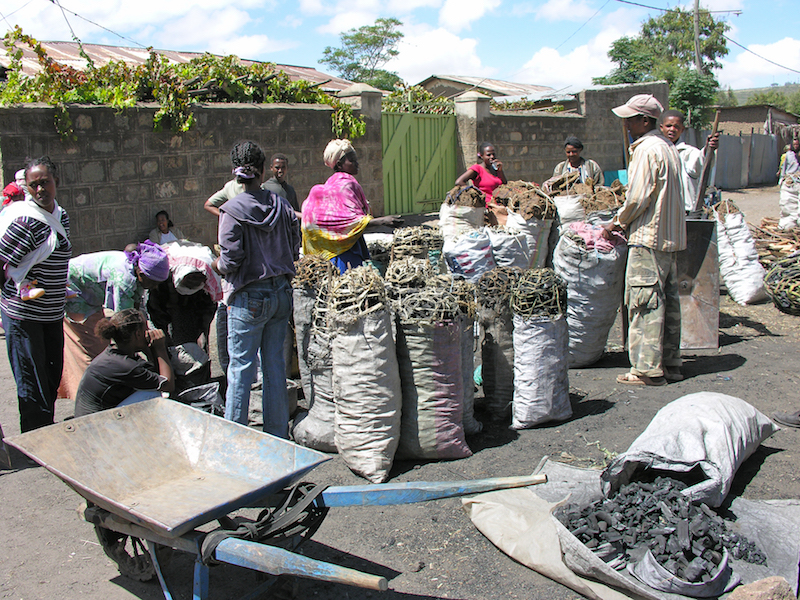Can sugarcane save Ethiopia’s dwindling forests?
Sugarcane harvest in Ethiopia (Wikipedia)
Ethiopia is one of the most beautiful countries in the world, with a rich and varied nature and wildlife.
However, the population growth and the need for arable land, wood and charcoal are all threats to the forests and the wildlife. In 50 years time the Ethiopian population has increased from 25 million to 100 million, while the forested area has decreased from over 40 percent to less than 3 percent of the country.
And Ethiopia is certainly not alone in this, because all African countries face the same problems of rapid population growth, the need for building materials, firewood and charcoal, and for arable land and settlements instead of forests. But the resulting deforestation on the African continent is also a major contributor to climate change, both locally and globally.
Other negative impacts of deforestation are the wide spread soil erosion and environmental degradation that follow the illegal cutting of trees for the production of firewood and charcoal. This threatens local food production, infrastructure and rural settlements.
In countries that have hydropower, the erosion is also causing a gradual filling of the reservoirs with sand and silt. Ethiopia’s oldest reservoir, 55 year old Lake Koka (70 sq. miles), which is located 50 miles south of Addis Ababa, is already largely filled with sediments. During the rainy season this causes uncontrollable overflows of the dam and floods in the downstream valley of the Awash river.
Firewood and charcoal are the most important fuels for households in Africa. According to a recent study[i] about 90 percent of Ethiopian households depend on wood and charcoal for their daily energy supply.
For indoor use charcoal is preferred because it produces less irritating and sickening smoke, but nevertheless it poses a threat to human health due to the poisonous but unnoticeable carbon monoxide (CO) gas that is produced during combustion. Especially women are at risk here, because they usually do the cooking, and also because CO can cause permanent damage to an unborn child.
The annual consumption of charcoal in Ethiopia is almost 4 million metric tons, most of which is illegally produced in traditional but inefficient and polluting ways, with a yield of only 8-15 percent. However, due to the enormous quantities, the production and distribution of charcoal are major sectors in the Ethiopian economy, which provide work, income and security to hundreds of thousands of people from the poorest rural communities.
It is clear that such a system of charcoal production is not sustainable in a situation of a growing population and dwindling forests. Tigray, Ethiopia’s northermost federal state, has already forbidden production of charcoal, which means that it has to come from other parts of the country.

So the Ethiopian government should start with a modernisation and training program of the charcoal industry, because modern killns will produce two to three times more charcoal from the same quantity of wood, than is possible with the present traditional methods. This will probably stop further deforestation and also eliminate the present environmental pollution and health hazards for the workers.
And there is a promising new possibility to produce household fuel from the waste material ‘bagasse’ from Ethiopia’s rapidly expanding sugarcane industry, which is an excellent bio-fuel and can be converted into fuel pellets or charcoal for domestic use.
The sugarcane industry in Ethiopia has started an ambitious expansion programm which will during the coming years gradually increase the the total daily crushing capacity from 20.000 tons of cane per day till more than 220.000 tons per day.
Sugarcane factories use the waste from the pressed cane, the ‘bagasse’, to generate their own energy. And modern, energy efficient sugarcane factories produce a considerable surplus of bagasse, which is a high quality and sustainable bio-fuel.
This surplus of bagasse can thus be used as a new energy source for households, in the form of briquets or pellets, or processed into charcoal. As fuel pellets the bagasse surplus will be enough to supply up to 50 percent of the national demand for household energy, and in the form of charcoal briquets it can supply up to 15 percent.
Either way, it is a promising new development that will open the possibility for succesful and large scale reforestation projects, not only in Ethiopa but in all countries that have a sugarcane industry as a source of alternative and sustainable energy.
[i] Reading through the charcoal industry in Ethiopia (2013). Forum for Social Studies, Addis Ababa, Ethiopia.

René van Slooten is a leading ‘Poe researcher’, who theorizes that Poe’s final treatise, ‘Eureka’, a response to the philosophical and religious questions of his time, was a forerunner to Einstein’s theory of relativity. He was born in 1944 in The Netherlands. He studied chemical engineering and science history and worked in the food industry in Europe, Africa and Asia.The past years he works in the production of bio-fuels from organic waste materials, especially in developing countries. His interest in Edgar Allan Poe’s ‘Eureka’ started in 1982, when he found an antiquarian edition and read the scientific and philosophical ideas that were unheard of in 1848. He became a member of the international ‘Edgar Allan Poe Studies Association’ and his first article about ‘Eureka’ appeared in 1986 in a major Dutch magazine. Since then he published numerous articles, essays and letters on Poe and ‘Eureka’ in Dutch magazines and newspapers, but also in the international magazines ‘Nature’, ‘NewScientist’ and TIME. He published the first Dutch ‘Eureka’ translation (2003) and presented two papers on ‘Eureka’ at the international Poe conferences in Baltimore (2002) and Philadelphia (2010). His main interest in ‘Eureka’ is its history and acceptance in Europe and its influence on philosophy and science during the late 19th and early 20th centuries.

